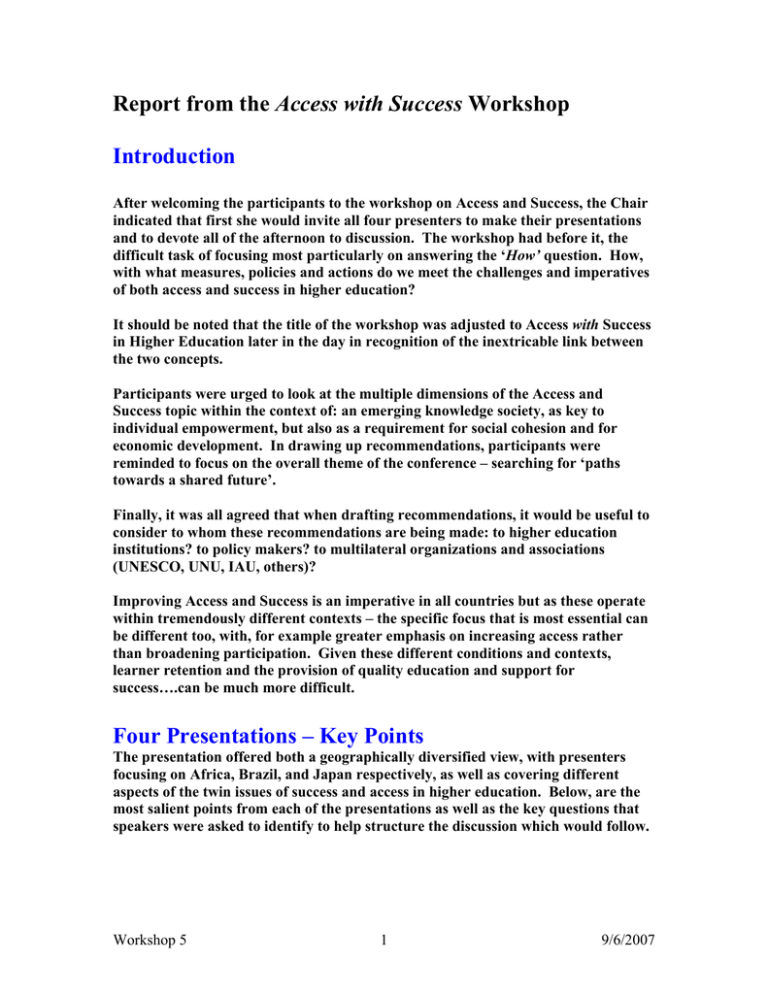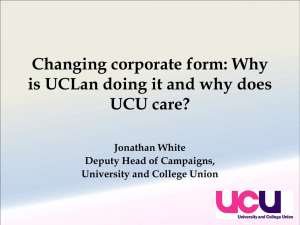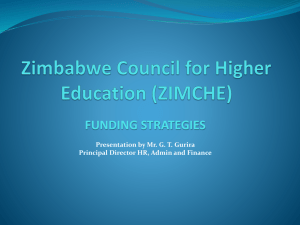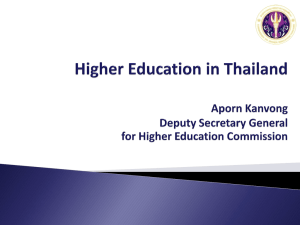Access with Success Introduction
advertisement

Report from the Access with Success Workshop Introduction After welcoming the participants to the workshop on Access and Success, the Chair indicated that first she would invite all four presenters to make their presentations and to devote all of the afternoon to discussion. The workshop had before it, the difficult task of focusing most particularly on answering the ‘How’ question. How, with what measures, policies and actions do we meet the challenges and imperatives of both access and success in higher education? It should be noted that the title of the workshop was adjusted to Access with Success in Higher Education later in the day in recognition of the inextricable link between the two concepts. Participants were urged to look at the multiple dimensions of the Access and Success topic within the context of: an emerging knowledge society, as key to individual empowerment, but also as a requirement for social cohesion and for economic development. In drawing up recommendations, participants were reminded to focus on the overall theme of the conference – searching for ‘paths towards a shared future’. Finally, it was all agreed that when drafting recommendations, it would be useful to consider to whom these recommendations are being made: to higher education institutions? to policy makers? to multilateral organizations and associations (UNESCO, UNU, IAU, others)? Improving Access and Success is an imperative in all countries but as these operate within tremendously different contexts – the specific focus that is most essential can be different too, with, for example greater emphasis on increasing access rather than broadening participation. Given these different conditions and contexts, learner retention and the provision of quality education and support for success….can be much more difficult. Four Presentations – Key Points The presentation offered both a geographically diversified view, with presenters focusing on Africa, Brazil, and Japan respectively, as well as covering different aspects of the twin issues of success and access in higher education. Below, are the most salient points from each of the presentations as well as the key questions that speakers were asked to identify to help structure the discussion which would follow. Workshop 5 1 9/6/2007 1. The Use of ICT for Increasing Access & Success in Higher Education in Africa (powerpoint provided) Goolam Mohamedbhai, President, International Association of Universities, Mauritius • • • • • • • In Africa, despite recent increases in enrolment, participation rates remain very low especially in Sub-Saharan Africa (5%), and gender inequity persists Expansion, including with cross border and new providers poses huge quality challenges Success is hindered by overcrowding, poor library resources, language issues, poor learning infrastructure and graduate unemployment ICTs on offer are varied – from radio to internet and including telephones and television, and all can and should be used in many ways, not only for distance or virtual learning but also to improve and expand face to face learning; ICTs can also improve management, especially with regard to students’ admission, credit accumulation and information 1.6 million teachers are needed to meet the goal of universal primary education by 2015 – judicious use of ICTs may offer the only means to achieving this objective Numerous obstacles stand in the way – especially the poor national information and communication infrastructure but also lack of enabling ICT policies at national and institutional levels There are initiatives and support programs underway, African HE needs to make the most of these to spread the use of ICTs for the benefit of Access and Success in HE 2. Access and Success: Connecting the dots (powerpoint provided) Mala Singh, Executive Director, Higher Education Quality Committee of the Council on Higher Education, Pretoria, South Africa and Vice Chair of the regional Scientific Committee for Africa, UNESCO Forum on Higher Education, Research and Knowledge • • • Enhancing access is a post World War II phenomenon; focus on success is more recent and linked to the move to stress ‘learning outcomes’ A contribution towards the larger agenda on global development – requires that HE is viewed as part of a whole - getting early education right is imperative Framing issues for addressing access and success: changes in mode of provision, differentiated missions of institutions, diverse student body, decline in public funding, external pressure on quality of provision and outputs and increased stakeholder power, including involvement of employers Workshop 5 2 9/6/2007 • • • • • • • • • • • Expanding access with quality – major issue for HEIs (and governments) as it has reputational value and impacts on public perceptions But Quality (and approaches to quality assurance) needs to be thought of within the context of regional/national agendas Fitness for purpose is the frequent consideration in QA in developed countries Fitness of purpose may be a more suitable approach given the variety of contexts as it takes into account whether the mission is what is actually needed, and the expected outcomes are relevant. etc) Poor primary/secondary education quality leads to difficulty in producing HE-ready students in Africa, including in South Africa especially for black students) Lack of preparation and skills in key role holders to effect access with success Essential to keep in view ‘equity of outcomes’ as well as equity in access UNISA experience casts doubt on effectiveness of Distance Education in expanding access successfully (14% graduation rates in 2005) Need for increased articulation between schools and universities, university to university and university to work Many social challenges – language of instruction; resources; social crises (HIV/AIDS); effectiveness and efficiency of HE (9 years for a 3 year degree??) Multiple strategic interventions and investments necessary – involving governments, institutional leadership and responsibilities for Quality Assurance Mala finished her presentation with the following questions for the workshop to consider: 1. What counts as success? 2. What are the factors needed to ensure success? 3. Access and Success to Higher Education in Latin America and the Caribbean: the case of Brazil, opportunities and challenges Paolo Speller, Political Scientist, Rector of the Federal University of Mato Grosso, Cuiaba, Brazil • • • In developing countries, colonial history has had a strong impact on HE tradition and system; different from one colonial power to another Do we over value the traditional model of the University? Do all countries have to follow the path of what happens in the developed world focusing on a single type of research intensive institution? Latin America must first eradicate illiteracy and develop quality basic education (10% participation rate HE) Workshop 5 3 9/6/2007 • • • • • • • • Enhancing access in large quantities and in an equitable fashion is difficult in Latin America because of poor infrastructure – basic education is linked to HE and is difficult to talk about one and not the other In Brazil, quality teacher education in public universities supplies good teachers to private schools; poor teacher education in private universities provides poor teachers to public schools Market forces led to the development of a large private HE system of low quality with most students attending private universities HE is insufficiently diversified or differentiated in Latin America as in most industrialized countries In Brazil government has tripled budgets to maintain and expand the HE system, including by strengthening and expanding public, federal universities which represent only 3% of total student enrolment at present Creation of scholarship schemes to increase and broaden participation (ProUni); another scheme was launched focusing on vocational/technical education Value and perception of HE changing – not just an one time activity, but ongoing through life The role of Distance Education in expanding access to education – merger of two modalities (face to face and DE) 4. Internationalisation strategy for Japanese Universities: Managing competition and collaboration (powerpoint provided) Masafumi Nagao, Professor, Center for the Study of International Cooperation in Education, Hiroshima University • • • • • • • • Changing context of higher education in Japan creating a shift from a sellers’ to a buyers’ market bringing about pressure for product differentiation School registrations and subsequent availability of students for HE has been declining (almost 25% less secondary school graduates in 2006 compared to 1996) Impact of globalization, need for ‘international-readiness’ by Japanese students; increased numbers of students from East and Southeast Asia Increasing emphasis on internationalization policies and approaches Strong Internationalization strategy in Hiroshima University Networking to promote collaboration – case of Links with African Universities Initiative Creation of South-Africa Japan University Forum Key advantage to networking approach – output adds to the intellectual infrastructure by facilitating access to new knowledge, new skills and new capabilities that are available elsewhere; capacity building. Chair’s report at the plenary Workshop 5 4 9/6/2007 In an emerging knowledge society access to HE is more important than ever but access without success is meaningless. Nations and society needs to consider the costs and implications of not finding ways to provide access and success in higher education Economic Growth targets would not be met; Social justice or social cohesion agenda would not be delivered; Intellectual capital would not be used to best effect for innovation; In short, the goals of the overall development agenda which we are discussing for our shared future would not be reached. Key premises/assumptions of the workshop discussion were o Some issues of access and success are beyond the control of HE o Expectations of HE and HE Institutions are growing, yet HEIs are not always given the means to meet these multiple expectations o Access and success must be seen as being interconnected Access with Success in higher education How we define Access depends very much on the context(s) and can be viewed as a continuum between increasing participation in quantitative terms to widening participation to embrace socio economic and minority groups. What counts as success is obviously more than simply getting people in. It can be measured by completion rates, quality outcomes and using all of society’s potential. Our measures of success need to be broader, perhaps accepting as well that students may enter HE, complete a module, gain knowledge and skills, but stop short of a qualification. Graduate employment should not be the only measure of success either as participation in HE brings other benefits to both individual and society. Access to higher education is better discussed in the context of interconnected education systems. The links are multidirectional as HE preparedness requires strong basic and secondary education and yet HE is also where the required quality teachers who can deliver this basic education are trained. As well, increased success in secondary school impacts on HE, creating more demand and pressure for expanding access. This dynamic process needs early policy recognition so that adequate resources are allocated to guarantee access with quality provision, thus success in the HE systems. In this regard the workshop recognized the systemic and holistic approach that needs to be taken for HE to play a central role in delivering quality Teacher Education, which in turn positively affects earlier levels of education and improves the conditions for access with success. Diversification of HE institutions and their missions is essential – the predominant academic/research model of the traditional university is not the only route to knowledge creation. We need to highlight the importance and value of differentiated HEI systems and recognize diverse ways of defining research and Workshop 5 5 9/6/2007 knowledge creation which includes academic/scientific research but also includes scholarship, problem solving and other ways of creating knowledge and offering opportunities for learning in new ways. HEIs need to act to reduce gaps in society, first by ensuring they do not widen them – they must be models of equitable institutions. They have the capacity, autonomy and responsibility to do so. Unless access with success is successfully addressed, given the requirements of the Knowledge Society, university education could, on the contrary, have a counter effect by widening the socio-economic gaps that already exist. The policy and program instruments and tools that can be used are to address equity in access with success include: • affirmative action but with policies to follow through inside institutions to prepare faculty and staff so that they can understand the needs and provide support to access students in ways that promotes success • Differentiated admission policies are important for broadening access and participation - by applying rigid selection processes universities can contribute to widening gaps • Expectations of standards/outcomes at exit should be the same in order to establish and maintain quality irrespective of admissions policy • Pedagogy, modes of delivery as well as the suitability of the curriculum on offer could be varied. A more flexible modularized curriculum which takes into account the needs of access students as well as the potential multicultural nature of the student body and the local contexts is likely to be more successful • Flexibility in systems to allow for student mobility; some form of certification to acknowledge what is achieved even if a particular course of study is not completed would aid success • ICTs have tremendous potential and go some way to improve access but are not the panacea; the full spectrum of technologies should be used as a means to improving learning for all students whether studying face to face or at a distance. • A convergence of distance education and face to face provision with effective use of ICTs could provide a very effective Blended Teaching and Learning approach. • Facing the large demand for Teacher Education, both initial and in-service, ICTs offer a variety of supports that can facilitate meeting the required targets. The workshop also discussed how some aspects of internationalization of HE could meet the Access with Success imperative, in particular drawing some distinctions between the networking, collaboration and partnership approaches and cross border educational provision, especially by an increasing number of private providers. It was agreed that indeed international networks and student mobility could increase and improve access as long as the curriculum on offer was relevant to Workshop 5 6 9/6/2007 the learners and the local context when delivered abroad and as long as measures to prevent the brain drain were in place in case of mobility schemes. Here participants noted that in a globalized world, the impact of actions, such as active recruitment, in one system of higher education – perhaps with a declining student enrolment, could have a major negative impact on another system. Recommendations o Policy and actions related to improving access and success in higher education must be set within the context of a holistic view of the education system and all its parts– basic education, secondary education, diversified HEIs, and connected with the outside – meeting the needs of the word of work and local and global societies o In a globalised world of growing competition among HEIs, to meet the access with success imperative, premium must be placed on internationalization approaches that favor networking, collaboration and partnerships and on mobility schemes that prevent the brain drain and promote brain circulation. HEIs but also bodies such as UNESCO, UNU and IAU must advocate and facilitate such approaches. o HE policy at governmental and institutional level needs to recognize that HE offered by a differentiated set of institutions, catering for diverse needs of learners as well as society, would improve access and success in higher education. o ICTs should not be seen as the panacea to increasing or widening access to higher education but should be seen as part of a continuum of modalities – DE and face to face, that can create a blended teaching and learning environment, facilitating learning for all. o Definitions of success should take into account contexts; measures of success should be cognizant of individual, institutional and systemic needs, expectations and criteria. Success should not only be judged by the number of graduates gaining employment. Educated people who are capable of seeing and understanding global issues and challenges are also an indicator of access with success. o Clear coherent policy frameworks and policies should be developed to ensure that access and success are viewed as a continuum of interconnected challenges. Access measures need to be properly funded, and accompanied by on-going learner support, appropriate monitoring, reporting and evaluation instruments, including solid data gathering and analysis at institutional and systemic levels. Workshop 5 7 9/6/2007 o HEIs should create formulae and policies for access based on merit that take the quality of prior education and socioeconomic background of learners into consideration in order to level the playing field and accompany learners towards successful completion. o HEIs must develop flexible curricula, assessment and certification approaches that retain quality but address broadening of access imperatives o Policy must be developed jointly by a variety of decision makers which includes HE professionals and institutions whilst retaining the learners very much at the centre of this process. Other issues raised in the presentations and subsequent discussions In addition to these main issues on which participants were able and had time to articulate recommendations, there were a number of other topics which merit being highlighted. These are listed below. • • • • • The developed and developing worlds need to work together in terms of increasing access and success. It is not a matter of one side helping the other but rather a mutual learning where all can benefit. Access of a different kind – cross border access to human resources to meet skills shortages in the workforce. What measures are needed to avoid brain drain and to ensure there is brain circulation or compensation to the country of origin? To what extent do universities need to redevelop a consciousness of international solidarity? How can they be helped so that financial imperatives do not drive their international strategies – particularly in publicly funded universities? Changes in Japanese demographics, similar to several industrialized countries, and their impact on secondary schools and HE recruitment led to the debate on how long current equilibrium can be sustained before major changes to educational systems need to happen. Language of instruction can be a major obstacle to using international cooperation as a response to unmet demand in some countries. English may need to be adopted in more HEIs in order to facilitate mobility. Thanks and Close The four presentations were very interesting and succeeded in bringing forward all of the central issues in the discussion of Access with Success. Workshop participants provided a lively contribution to the discussion and demonstrated that the issues and strategies are numerous and often complex. The Chair thanked Workshop 5 8 9/6/2007 them all, and most especially Christina Lloyd for her contribution to drafting these notes and recommendations. Eva Egron-Polak, Secretary-General, International Association of Universities Workshop Chair Christina Lloyd, Head of Teaching and Learner Support, The Open University, UK Workshop Coordinator and Rapporteur Workshop 5 9 9/6/2007





